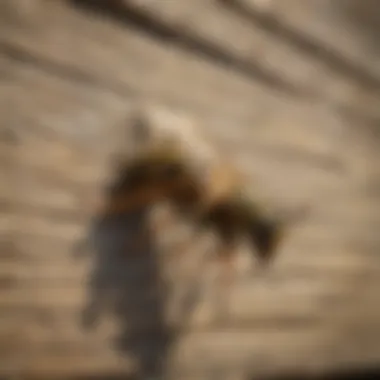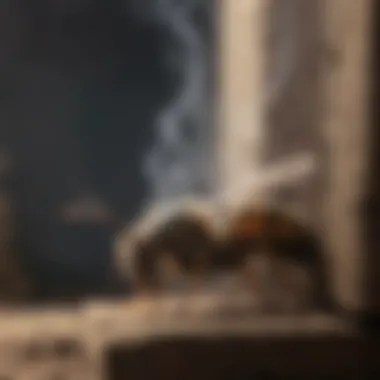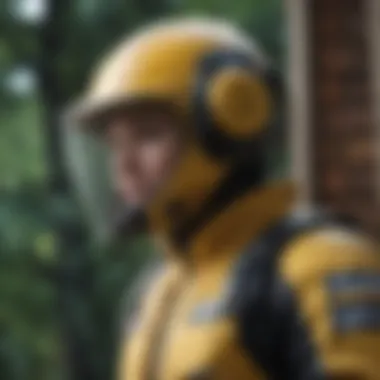Expert Strategies for Removing Wasps Safely from Your Home's Siding


Preventive Pest Control Strategies
When it comes to pest control, taking proactive measures is key to ensuring a pest-free home environment. Starting with House Exterior Protection, it is crucial to seal any cracks or openings that may serve as entry points for pests. Clearing debris such as fallen leaves and woodpiles is essential to eliminate potential hiding spots for insects and rodents. By implementing these simple tips, you can prevent pests from infiltrating your home.
In addition to safeguarding the exterior of your house, Yard Maintenance plays a significant role in pest prevention. Engaging in essential yard care routines like regular mowing, trimming of shrubs, and removing standing water helps reduce pest attraction to your yard. Utilizing methods such as planting pest-repelling plants and employing natural pest control solutions can also contribute to maintaining a pest-free outdoor space.
Maintaining Indoor Cleanliness is equally important in warding off pests. Expert cleaning tips recommend thorough vacuuming, proper food storage, and sealing cracks in walls and windows to prevent insect entry. By creating a pest-resistant indoor environment through regular cleaning and maintenance, you can significantly reduce the risk of pest infestations.
Proper Garbage Disposal is a critical aspect of pest control that is often overlooked. Efficient waste disposal methods involve using sealed containers, disposing of garbage regularly, and keeping outdoor bins clean. The importance of proper garbage disposal lies in eliminating food sources that attract pests, thereby reducing their presence in and around your home.
To complement these strategies, exploring Other Pest Prevention Strategies can offer innovative ways to safeguard your home. This includes techniques such as installing door sweeps, using mesh screens on windows, and sealing utility entrances to fortify your home against potential pest invasions.
Understanding the Wasp Behavior
Understanding the behavior of wasps is crucial in effectively addressing the issue of wasps nesting in your siding. By delving into the intricate patterns and tendencies of these insects, you can adopt targeted strategies to discourage their presence. This section will explore the social structure of wasps, shedding light on how their hierarchical organization impacts their choice of nesting locations. Additionally, we will discuss the factors that attract wasps to siding, enabling homeowners to proactively take measures to deter them.
Identifying Wasp Nests
The Appearance of Wasp Nests
When identifying wasp nests, it is essential to recognize their characteristic papery appearance, usually in shades of grey or brown. These nests are meticulously constructed from wood fibers mixed with saliva, resulting in a durable yet lightweight structure. The hexagonal cells within the nest provide compartments for larvae development and food storage, showcasing the intricate architecture engineered by the wasps. Despite their intricate design, these nests pose a threat due to their close proximity to human dwellings.
Common Nesting Locations
Wasp nests are often found in sheltered areas such as eaves, attics, and wall voids, providing protection from the elements and potential predators. Additionally, dense vegetation and cluttered outdoor spaces serve as ideal nesting grounds for wasps seeking seclusion. Understanding these common nesting locations is paramount in effectively locating and addressing existing nests to mitigate the risks associated with displacing these stinging insects.


Wasp Behavior Patterns
Social Structure of Wasps
The social structure of wasps consists of distinct castes, including queens, workers, and drones, each fulfilling specific roles essential for colony survival. Queens are responsible for reproduction and nest initiation, while workers gather food, care for the young, and defend the nest. Drones, on the other hand, are male wasps whose primary function is mating with the queen. This hierarchical organization influences the behavior patterns of wasps, dictating their interactions and nesting preferences.
Factors Attracting Wasps to Siding
Several factors can attract wasps to siding, including the availability of food sources such as nectar, insects, and human meals. Additionally, the presence of sheltered crevices and building materials resembling natural nesting sites can inadvertently lure wasps to establish colonies near residential structures. Understanding these attractants enables homeowners to implement preventive measures that discourage wasps from infesting their siding and mitigate potential nesting activities.
Natural Remedies for Wasp Removal
In the realm of wasp control, exploring natural remedies offers a powerful and eco-friendly approach to tackling these unwanted guests in your home's siding. Natural remedies stand out for their gentler impact on the environment while effectively addressing wasp infestations. By incorporating natural elements into your pest management strategy, you not only safeguard your living space but also contribute to a sustainable ecosystem around your home.
Peppermint Oil Solution
Preparing the solution
When delving into the realm of natural wasp deterrents, the peppermint oil solution emerges as a frontrunner due to its potent properties that repel wasps effectively. The key characteristic of this solution lies in peppermint oil's strong scent, which disrupts the wasps' olfactory senses, deterring them from nesting in your siding. The unique feature of the peppermint oil solution is its non-toxic nature, making it a safe option for households with pets and children. While its pleasant aroma is appealing to humans, it acts as a formidable barrier against wasps, ensuring a peaceful coexistence between inhabitants and buzzing intruders.
Application method
The application method of the peppermint oil solution further enhances its efficacy in repelling wasps. By diluting peppermint oil with water and transferring the mixture into a spray bottle, you can conveniently cover targeted areas on your siding where wasps tend to build nests. Spraying the solution along potential entry points and known nesting sites creates a barrier that dissuades wasps from settling in these spaces. The simplicity and accessibility of this application method make it a popular choice for homeowners seeking a natural and efficient way to deter wasps from their property. While the peppermint oil solution boasts numerous advantages in warding off wasps, it's important to note that reapplication may be necessary after rainfall to maintain its repellent effect and preserve your wasp-free environment.
Professional Pest Control Services


When dealing with a wasp infestation on your siding, considering professional pest control services is crucial. Entrusting certified exterminators with the task ensures a safe and effective removal process. These professionals have the expertise and proper equipment to handle wasp nests securely, minimizing risks for both homeowners and the environment. One significant benefit of opting for professional pest control services is the assurance of thorough and lasting removal, preventing reinfestation. Moreover, certified exterminators adhere to industry standards and safety protocols, guaranteeing a job well done.
Hiring Certified Exterminators
A crucial aspect of professional pest control services is the process of hiring certified exterminators. Researching reputable pest control companies is essential to ensure the expertise and reliability of the hired professionals. Homeowners should look for companies with a proven track record in wasp nest removal and positive customer feedback. Choosing certified exterminators offers the advantage of specialized knowledge and experience in handling various pest infestations. These professionals undergo rigorous training to provide effective solutions tailored to specific needs, ensuring a successful outcome.
Comparing Service Offerings
Comparing service offerings among pest control companies is a key step in securing the right expertise for addressing a wasp infestation. Homeowners should evaluate the range of services provided, including inspection, treatment processes, and follow-up measures. By comparing the service packages of different companies, individuals can identify the most comprehensive and cost-effective solution for their specific situation. Considering factors such as response time, warranty offers, and environmentally friendly practices can help in making an informed decision to tackle the wasp problem effectively.
Treatment Processes
In the realm of professional pest control services, treatment processes play a vital role in eradicating wasps from siding areas. The inspection of the siding is the initial step in determining the extent of the infestation and planning an appropriate intervention. Through thorough examination, certified exterminators pinpoint nest locations and assess potential entry points, devising a targeted strategy for removal. This comprehensive approach ensures that no nest is left behind, minimizing the risk of future infestations.
Inspection of the Siding
Inspection of the siding is a meticulous process that involves assessing all exterior surfaces for signs of wasp activity. Certified exterminators inspect eaves, soffits, and wall crevices to identify nesting sites and gauge the population of the colony. By conducting a detailed examination, exterminators can tailor their approach to the specific characteristics of the infestation, enhancing the efficiency of the removal process.
Safe Removal of Wasp Nests
Safe removal of wasp nests is a critical aspect of professional pest control services to ensure the well-being of both occupants and the environment. Certified exterminators utilize specialized techniques and equipment to dismantle nests without causing harm or dispersing aggressive wasps. By employing safe removal practices, these experts safeguard against potential stings and allergic reactions, prioritizing the safety of homeowners. Additionally, the proper disposal of removed nests minimizes environmental impact, completing the removal process effectively.
Preventive Measures and Maintenance
Preventive measures and maintenance are crucial aspects addressed in this article to effectively remove wasps from your siding. By implementing these strategies, homeowners can proactively prevent wasps from nesting on their property, ensuring a safe and comfortable environment. Taking steps to seal cracks and crevices in the siding not only prevents wasps from building nests but also helps in maintaining the structural integrity of the home. Regular cleaning practices play a significant role in eliminating potential food sources that attract wasps, reducing the likelihood of infestation. Additionally, maintaining a clutter-free environment not only deters wasps but also enhances the overall aesthetics of the property.


Sealing Siding Cracks
-#### Identifying Entry Points
Identifying entry points along siding is a crucial step in effectively removing wasps. By closely inspecting the exterior of the home, homeowners can locate openings where wasps may enter to build nests. This proactive approach enables individuals to address vulnerabilities in the siding, preventing future infestations. Identifying entry points is essential for targeting specific areas for sealing, creating a barrier that discourages wasps from nesting on the property.
-#### Applying Sealants Effectively
Applying sealants effectively is paramount in sealing siding cracks to deter wasps. Utilizing high-quality sealants, homeowners can efficiently fill gaps and crevices along the siding, creating a seamless barrier that prevents pest entry. The application of sealants should be thorough and precise, covering all potential entry points to eliminate any opportunities for wasps to establish nests. While applying sealants effectively requires attention to detail, the long-term benefits of a well-sealed siding far outweigh the initial effort, ensuring a wasp-free environment.
Regular Cleaning Practices
Regular cleaning practices significantly contribute to the prevention of wasp infestations on your property. Removing food sources that attract wasps, such as fallen fruits or crumbs, reduces the incentive for these pests to linger near the siding. By maintaining a clean environment, homeowners can minimize the risk of attracting wasps and other pests, promoting a hygienic and pest-free living space. Additionally, focusing on maintaining a clutter-free environment not only enhances the visual appeal of the property but also eliminates hiding spots for wasps, further deterring them from nesting.
-#### Removing Food Sources
Removing food sources around the home is essential in deterring wasps from the property. By promptly cleaning up spills, disposing of food waste properly, and securing trash bins, homeowners can eliminate attractants that entice pests. This practice not only reduces the presence of wasps but also enhances overall cleanliness and hygiene within and around the home.
-#### Maintaining a Clutter-Free Environment
Maintaining a clutter-free environment is key to preventing wasps from nesting near the siding. By organizing outdoor spaces, removing debris, and storing items properly, homeowners can eliminate potential nesting sites for pests. A clutter-free environment not only minimizes the appeal of the property to wasps but also fosters a tidy and welcoming outdoor atmosphere for residents and guests.
Landscape Maintenance Tips
Effective landscape maintenance plays a vital role in preventing wasps from establishing nests on your property. Triming bushes and trees near the siding reduces harborage areas for wasps, limiting their nesting opportunities. By strategically pruning foliage and maintaining a well-manicured landscape, homeowners can create an inhospitable environment for pests. Additionally, weeding around the perimeter of the property eliminates overgrown vegetation that serves as potential nesting grounds, further reducing the risk of wasp infestation.
-#### Trimming Bushes and Trees near Siding
Trimming bushes and trees near the siding is an essential practice to deter wasps from nesting. By keeping vegetation trimmed and well-maintained, homeowners can minimize cover and nesting spots for pests, discouraging their presence. This preventive measure not only enhances the aesthetic appeal of the property but also limits access points for wasps, promoting a wasp-free environment.
-#### Weeding around the Perimeter
Weeding around the perimeter of the property is crucial in eliminating sheltered areas for wasps. Removing weeds and excess vegetation not only enhances the visual appeal of outdoor spaces but also reduces hiding spots for pests. By regularly weeding around the perimeter, homeowners can create a clean and well-maintained environment that deters wasps and other pests from taking up residence, ensuring a pest-free and inviting outdoor area.



